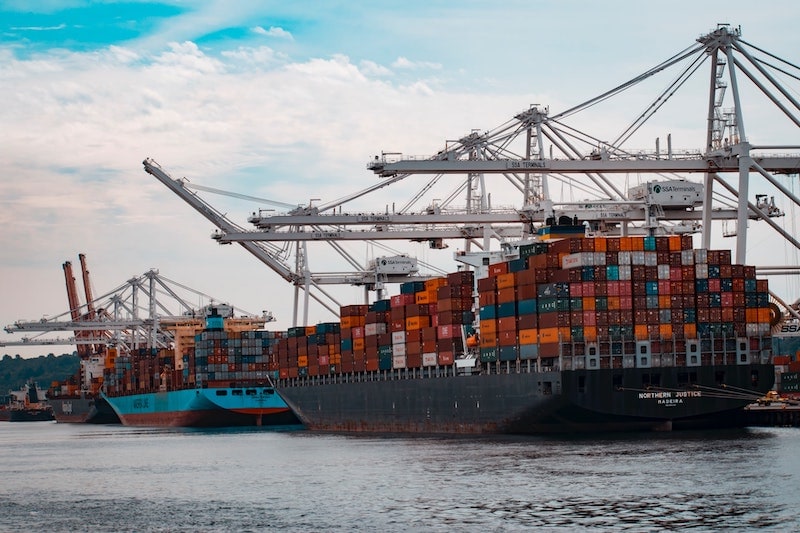
In a world changed by the outbreak of an epidemic, information about the product on its label is not enough. Nowadays, consumers have to be 100% certain that the product they purchase is safe. That’s why the modern supply chain has to step out of the shadows and show customers the previously insignificant retail backstage. And this is where the blockchain and Internet of Things (IoT) technologies come into play. For the sake of our safety and comfort.
Do you even remember drinking a can drink that you’ve just bought in a store or a vending machine without disinfecting it? Would you, just a few months ago, disinfect its lid with a 70% alcohol solution? Probably not. Unfortunately, we can expect that this scenery will stay with us for a while. More and more diseases and germs will be attacking us and our economy alike in the coming months and years.
The answers to the COVID-related questions have become worth their weight in gold just overnight:
- How long does coronavirus stay on paper, and how long on metal or plastic packaging?
- How can we disinfect our purchases after bringing them home?
- Does the responsibility for the safe use of the products bought in brick-and-mortar or online stores really lie with the customer?
Modern consumers want to be assured that the products they buy were not contaminated with microbes or harmful substances at any of the production and delivery stages, and they can safely unpack and use it. But how can you provide the customer with such a guarantee and knowledge of the journey travelled by the product?
More importantly, with the growing number of orders in e-commerce (and the increasing number of deliveries the same way), the vital question arises: ‘How to ensure the security of mass sales?’
The IoT and blockchain technologies come to the rescue!
Indeed, these two technologies have all the necessary potential to ensure that we buy safe products and even on a mass scale. How is that possible? To answer that question, we ought to take a closer look at both these technologies.
WHAT IS IoT (INTERNET OF THINGS)?
Simply put, IoT is all about extending the internet beyond computers and smartphones to a whole range of other things and processes. In other words, IoT means taking various items and devices and connecting them to the internet. It all sounds great, but how can it enhance the production and delivery processes? Here’s how:
IoT allows us to install a multitude of various sensors that measure all the relevant parameters (temperature, motion, light, air quality, etc.) in places and vehicles where products are made, stored, and transported. Constant monitoring of data coming from our environment makes automated analysis and taking action accessible.
One of the best-known examples of IoT is the air quality monitoring system. Sensors located in the cities or buildings transfer data about air to the main system. Next, many user can see it via a mobile app in real time! This system can also track the users’ activity in the application, for instance, the most frequently checked locations. In the same way, users can monitor the soil quality or the number of people in contact. We call it smart farming.
WHAT IS BLOCKCHAIN?
If you asked a randomly selected Internet user to explain what blockchain is and what category of inventions it belongs to, the complexity of this question could compete with quantum physics. It’s like a black hole. We all seem to understand the concept, but it takes knowledge and intellectual effort to explain them correctly.
So, let’s try to put it as straightforward as possible. Blockchain is a specific registry that enables the storage and transmission of data in a decentralized, verifiable, and constant way. Perhaps, the vast majority of our readers think of blockchain as of cryptocurrency technology. And it’s true, this technology is broadly used in cryptocurrency transactions, but not only there.
Blockchain allows you to save data (for instance, regarding transactions) in the form of successive blocks connected chronologically in a chain (hence its name). Each user taking part in this transaction has a copy of the full database stored within a chain. Thanks to that solution, data and its flow is dispersed and decentralized, and thus – safe. This means that the chain cannot be changed by single system user.
If you’d like to find out more about blockchain, we encourage you to read our article about blockchain in marketing.
So, if IoT is the first piece of our puzzle, blockchain is the second piece, and third is the e-commerce and retail industry, what kind of a picture emerges?
How can your company use IoT and blockchain in retail?
If, while reading this article, you thought “It’s just a fad, I’ve never heard about real-life applications of IoT or blockchain”, we have some bad news for you. It’s not a fad, and there are solid numbers to support our thesis. Moreover, further in the text, we will show you three real-life applications of these technologies.
- The global IoT in the retail market was valued at 22.36 billion USD in 2018 and is expected to reach 69.25 billion by 2024.
- IoT software solutions flourish and provide for the betterment of the retail sector. Currently, there are over 10 software solutions to choose from: Qliktag, Evrythng, ThinFilm NC solutions, Gimble, Kaa Projects, Wise Shelf, Swirl, Memomi, Authentic or Not, Queuehop[1].
- According to a new report, “Retail Industry Digital Outlook”, 80% of respondents credited the IoT with improving existing business operations, while 45% said it solved new problems, and 47%claimed it created new opportunities.
So, yes, retail and e-commerce can benefit hugely from these two technologies. And here’s how:
CERTAINTY IS WORTH MORE THAN TRUST
Blockchain removes obstacles and increases the visibility of consumer products, their production process, and retail business transactions. Greater transparency through a shared, immutable ledger enables businesses and customers to create an atmosphere of sincerity. With IoT and blockchain, companies don’t have to ask customers to believe they fulfill their promises. They can show they do! As a result, companies can build trust and collaboration across the global supply chain with real-time, universal insights into products and processes.
SUSTAINABLE RETAIL
For a lot of consumers, it’s immensely important to know that they buy eco-friendly products, produced with sustainability in mind. Currently, we have to believe “100% eco” stickers placed on products’ packaging. In the near future, we will have insight into an explicit confirmation with solid data to support it.
For instance, the IoT sensors installed at the farmer’s ranch or in the orchard will show, i.a. whether the level of irrigation of the plantation or the mineral content of the soil meets the agreed conditions. We will be able to track and control the amount of water used in production. We can also check the product’s carbon footprint or the number of kilometers traveled from the producer to the recipient. All of that data will be visible and accessible to every customer, possibly even in the store! The full picture of product production – from raw materials up to delivery – brings the brand significantly closer to the consumer. And that creates an entirely new, unique customer experience.
CASE STUDY: WALTONCHAIN
Waltonchain is an open-source platform based on blockchain and IoT technology, including the RFID (Radio Frequency Identification) chips. The goal of the project is to create a new retail ecosystem for the exchange, processing, and storage of product information that ensures full transparency, security, and reliability. In other words, the company builds a worldwide network of “smart objects”, and connects them to the internet.
These objects will have embedded sensors that gather data about their external environment. The sensors can track the entire production and transportation process and monitor location, time, temperature, humidity, and other relevant parameters. Next, that data is sent, via blockchain, to the decentralized database, so that it can be verified by third parties – customers, stores, restaurants, etc.
You can read more about this project here.
CASE STUDY: AMBROSUS (AMB)
A certain portion of tokens is pinned to a product, and then, as that product moves through the supply chain, information about how it’s handled and where it has been is attached as metadata to that token. The received data is next uploaded to blockchain in order to share it among counterparties. The result is ‘a smarter, healthier and transparent food and pharma ecosystem connecting producers, retailers, consumers, and markets’[3].
Ambrosus is a blockchain and IoT project primarily concentrated on two industries: food and pharma. They are working on a specific tracking system, a combination of sensors that can track movement, temperature, and other parameters across the entire supply chain and production. Ambrosus uses RFID chips, tokens, QR codes, or other interactive ways to get and set data. The tokens are used to represent an item that’s being tracked on the blockchain.
If you want to read more about Ambrosus go here.
CASE STUDY: VECHAIN (VEN)
Find out more about this project here.
VeChain is building a decentralized platform for business (especially retail) solutions, on which companies can easily interact and transact with each other without any intermediary. VeChain makes it easy and safe for manufacturers to share product data with vendors and consumers. How so? VeChain uses blockchain for secure and immutable data storage for the entire supply chains.
Each organization in the given supply chain will have access to the information through their private key. This means that each node in the supply chain will have access to the same data and use the same accounting procedures. Once a supply chain is on the VeChain platform, every party can easily transact with all the organizations within the chain and have an insight into it. This “360-degree view” of the supply chain both informs the parties responsible for bringing the product to market and guarantees consumers are receiving what they paid for.
Blockchain & IoT in retail is a human, not technology-driven approach
Until now, the assurance about the safety of the product could have only been carried out by means of a certificate, i.e. the declaration of the certifying authority. In the blockchain world, this certificate is a publicly available register of stages (chains) through which the product passes on the way from the factory to the consumer. It’s a solid, proven confirmation of actions taken by the manufacturer, distributor, and supplier in order to ensure that product you purchase is 100% safe and produced in a promised way.
That’s why we can state that combining blockchain & IoT sensors is an answer to the demand coming from the market. And current pandemic the world struggles with has only emphasized it. We want to be sure that the products we buy are safe and produced as expected. At least currently, these two new technologies are the most straightforward and most efficient way to make that happen.
If you’d like to talk about implementing blockchain and IoT in your company or simply talk about various ways to enhance your business – drop us a line. Improving businesses is our thing! The Innovatika team will gladly help you with all your endeavours.







